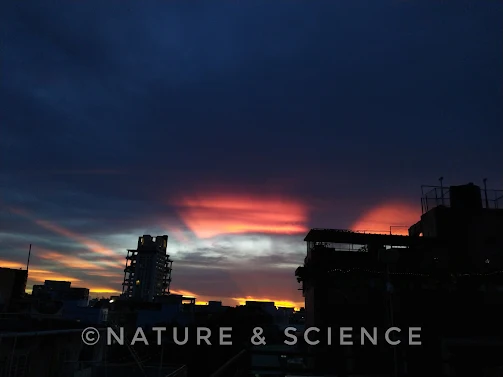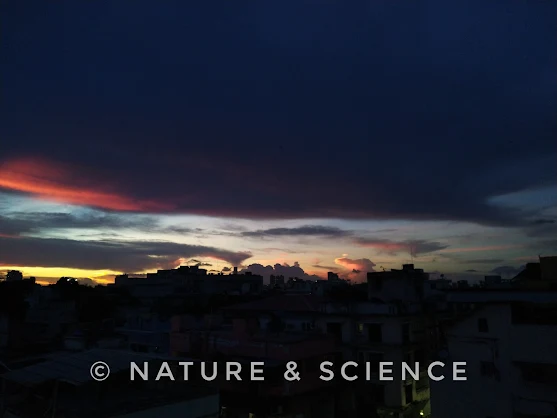Do you know what causes the blue color of the sky? A deceptively simple question, yet it left some of our brilliant physicists scratching their heads in growing frustration. Because they were unwilling to give up, we finally know why. And how.
It turns out that the sky appears blue because of something called Rayleigh scattering. Sunlight passing through Earth's atmosphere gets scattered in all directions by the atoms and molecules of nitrogen and oxygen. Sunlight, as you must have seen if allowed through a prism, gives way to a spectrum of seven colors - violet, indigo, blue, green, yellow, orange, and red. In effect, there are only six colors. And that'll be a story for another day. When ''normal, white'' sunlight falls on a nitrogen or oxygen molecule, light from the blue (including indigo and violet) portion scatters more than yellow, orange, and red. Since the blue light scatters uniformly in all directions, the sky gets its familiar azure shade when the sun hangs high in the firmament directing all its wrath (rather heat) on your head.
Fair enough. Now what about sunsets and sunrises? Clearly, we don't see a blue sun rising, but the most reddish orb one can think of. If you ever wake up to a blue sun rising, then voila! You are likely on Mars. Want a green one? Ask Master Gibbs.
Okay, so here's the thing. Rayleigh scattering is overtly responsible for making sunsets red. When the sun is near the zenith, its rays fall upon us perpendicularly, traveling through what you can say, one atmosphere of air. Even though we speak of sunsets and sunrises, the sun never sets or rises. Earth spinning on its axis from west to east projects the sun to rise east and set west. As the Earth turns, the perpendicular rays of the sun progressively slant. Inches above the horizon, the sun's rays travel tangentially through the atmosphere. On this lengthened path, the thickness of the atmosphere increases to include almost 40 times as much (volume of) air when the sun is overhead and its rays perpendicular. This additional air causes so much scattering that the sunlight, when it reaches us, carries only the low-frequency lights from yellow to orange to red.
This piece isn't going to be on Rayleigh scattering but about something I picked up while drafting those articles last year. Crepuscular rays can seduce your inner romantic. Before you get your hopes up, here's what I'm blabbering about.
This.
 |
Crepuscular Rays I captured at sunset with my phone on 23rd July,
06:34 pm local time in Kolkata, West Bengal, India. |
And this.  |
| Another shot. |
Crepuscular, from the Latin Crepsuculum, means twilight. Often they are also tagged as twilight rays. As you can see, this is where the word sunbeam comes from.
I snapped these around 06:34 pm local time. The sun had set at 06:21 pm. I was sitting by the window, lost in a captivating book - Moon: A Brief History (by Bernd Brunner, in case you are a fellow bookworm). I'm glad I had not turned on the lights and was straining my eyes. With myopia in both eyes, I have been advised not to read under dim illumination. Had I been too obedient, I would've totally missed it. As I was progressing through the pages, the monotone blue of the sky, as always, softened by degrees into the warmer, fiery hues. Red symbolizes love - passionate, nubile love. Seeing the sky blushing in shades of yellow, orange, and red, little could I focus on the book. Breaking a thing or two, I rushed to the balcony. One look and I stood motionless for a second before I could gain my composure and steady my hands for a few snaps.
Reading about them is good. Being able to understand what causes them is even better. But seeing them with your mere mortal eyes for the first time can be exhilarating. Since a building interrupted my view, I grabbed my phone and hurried to the terrace. Now with the entire western sky before my eyes, I am sure I missed a beat or two. Nature has this odd habit of surprising you when you're least prepared. Not that I mind.
Crepuscular rays emerge when the sun moves behind a layer of clouds. Clouds can be almost transparent or impenetrably opaque based on how much water they contain. The volume of water they carry gives them their color - white, grey, or bluish-black. Dense storm clouds come with the blackest shade. If there is a gap, a hole, sunlight from the other side emerges as a sharply defined beam, much like a spotlight. The spotlight effect is seen (as long as you're at the right place and time) during the day when the sun arcs through its highest point in the sky. Here's a nice picture from the good old Wikipedia to showcase my point.
 |
Sunlight creeping through clouds. ''Sunrays'' emerge due to the mist and
other suspended aerosols acting as Tyndall scatterers.
Image Credits: Public Domain, via Wikimedia Commons |
This particular batch of crepuscular rays is enhanced in the wake of mists (tiny water droplets floating in the air). I remember seeing them once. The only downside, I was too young to pronounce "crepuscular" under one breath, let alone understand the science behind them.
The best rays emerge during sunset/sunrise, in the few moments after the sun has set or is yet to rise. As you see in my first two photographs, although the beams appear to diverge from a point where the sun has set, it is only a visual illusion, where in reality, the rays are as parallel as they can be. This perspective effect is akin to the converge of parallel railway tracks as we look towards the distant horizon. Sometimes, these crepuscular rays, diverging from the western sky (suppose), stretch across the celestial dome and apparently converge in the eastern sky. Convergence happens at what is known as the antisolar point, opposite the sun in the celestial dome. Therefore, the converging sunbeams are called antisolar rays (during the day) or anticrepuscular rays (at twilight).
 |
Crepuscular Rays seen around sunset over the Indian subcontinent.
Image Credits (Original): Earth Observatory NASA. |
Only if you happen to be astronauts onboard the International Space Station, circling the Earth some 400 km above the surface, can you see that crepuscular rays are indeed parallel. The following image was acquired on October 18, 2011, while the ISS flew over India. NASA notes - The sun was setting to the west (image left) to the Indian subcontinent, and cumulonimbus cloud towers provided the shadowing obstructions. The rays being projected onto a layer of haze below the clouds.
Crepuscular rays can happen anytime during the day, as long as there are clouds, and can be seen anywhere on Earth. Clouds need not be the only ones casting the shadow. During twilight, sunlight falling onto the rugged and jagged outlines of mountains also gives rise to a similar effect. Crepuscular rays are not rare, except they depend upon certain factors, the most important being the object casting the shadow. The moment the sun sets, the sky stops being directly illuminated by the sun's rays and continues to glow for quite a while due to atmospheric refraction. Right before sunset, the incoming sunlight traverses through the greatest length of the atmosphere and nearly grazes the Earth's surface. In order to cast a shadow, the object has to be large enough to get in the way. As it blocks the grazing sunrays a sharp shadow spreads across the sky. Other than that, for the crepuscular rays to be distinct, the surrounding sky must be dark enough to bring out the tonal contrast between light and darkness.
Since I had to edit the first two images to bring out the colors, here is an unedited version that shows the amount of available light. A good cloud cover can act as a backdrop for projecting the rays. Since you wonder, stratocumulus clouds, the type you can see in my captures, are responsible for the emergence of crepuscular rays. At the same time, they also drop the curtain before the featureless blue (twilight sky) sky where to enact the Game of Shadows.
%20(2).jpg) |
| Unedited version |
I am sharing a link to a reputable website EarthSky where you can look at hundreds of photos of crepuscular rays captured across various locations. Sometimes it's a lone mountain etching out a dark shaft over a sheet of altocumulus clouds. At other times a towering column of nimbus cloud casts an umbral shadow onto the golden yellow twilight sky.
 |
Captured at 06:36 pm local time.
|
Had there been no atmosphere, sunrise, and sunset would have been most abrupt. With the sun going down, in a hair's breadth, day will turn into night. If you ever settle on the moon, you'll have to adjust to this swift transition. Rayleigh scattering creates a haze of stray light bouncing off oxygen and nitrogen molecules. Too much bouncing removes the slightest touch of blue, turning the sun into an oversized red cherry. On the moon, however, with no atmosphere, the daytime sky speckles with stars, except where the sun shines with full might, dazzling like a true star.
Being in the rush robs us of the little healing touch Nature graciously offers to our sinking shoulders, tired bodies, fatigued eyes, and burnt-out souls. When you are living from paycheck to paycheck, when your unpaid bills pile up, and the deadline runs out, when you are almost all the way dead, the sky will violently explode in tones of red, rosewood and crimson, golden yellow and dull orange, a little pink there and some violet over there. You'll realize that all bad things pass, that the Earth ceaselessly turns and will keep on for eons - when you'll be long gone - when your children's children and their children will become history. As the last rays of the sun hit your eyes, you'll know that the Earth will turn some more to bring the sun up again in the morning. Light will always be there somewhere to halt the coming of night. Life will eventually triumph over death. And even though at some point in the unimaginably distant future, time itself will become meaningless, you'll look to your wristwatch just as a good reflex. 06:36, it reads.




%20(2).jpg)



Comments
Post a Comment